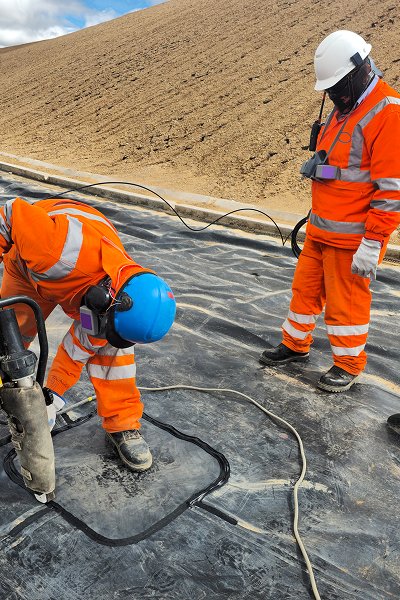Infrastructure construction and environmental protection in Middle Eastern countries such as Saudi Arabia and the United Arab Emirates are entering a stage of high-quality development. Faced with extreme environments such as high temperature, strong ultraviolet rays, saline-alkali soil and polluted liquids, HDPE geomembranes have excellent anti-seepage performance, chemical stability and service life, and are widely used in petrochemical pools, drilling sewage pools, landfills and other projects, becoming a key environmental protection and engineering basic material in the Middle East.
Why is HDPE geomembrane the preferred material in Middle Eastern countries ?
Geomembrane has strong high temperature and weather resistance and is suitable for desert climate. The Middle East has strong sunshine and extremely high temperatures, and the surface temperature in summer often exceeds 60°C. HDPE geomembrane has UV stabilizers and antioxidants (AO) added to the raw materials, which can withstand temperature differences from -60°C to +85°C, is not easy to age, crack or soften and deform, and is more stable than traditional membrane materials such as PVC.
Surface wear caused by wind and sand scouring
In desert construction and use environments, wind and sand movement will continuously impact the membrane surface, causing the following problems:
Long-term wear causes the membrane thickness to decrease
Friction coefficient decreases → slopes are prone to sliding
Joints are prone to peeling, resulting in leakage risks
Application of HDPE geomembrane in petrochemical industry
Oily wastewater pool lining system
A large amount of oily wastewater is generated during oil extraction and refining, and the wastewater is highly corrosive and volatile. HDPE geomembrane, as an anti-seepage liner, can effectively prevent waste liquid from leaking into the ground and protect water bodies and soil.
Crude oil tank farm anti-seepage layer
Once a leak occurs in a crude oil tank farm, it is very easy to cause serious pollution. HDPE geomembrane is often used for laying under the tank and in the cofferdam area to form a complete secondary protection system.
Chemical storage and transfer area
Including chemical liquid storage tank areas such as hydrochloric acid, sulfuric acid, sodium hydroxide, methanol, etc., it is necessary to set up a strong acid and alkali resistant anti-seepage layer. HDPE membrane has become the preferred material due to its excellent chemical inertness.
Oil drilling mud pool and emergency accident pool
The mud, waste liquid and accidental leakage generated during the drilling process must be temporarily collected and stored. HDPE geomembrane can be quickly deployed to form a reliable anti-seepage pool.


| Property | Benefit |
|---|---|
| Chemical Resistance | Withstands oils, fuels, acids, alkalis |
| Thermal Tolerance | Performs in extreme hot & cold climates |
| Low Permeability | Prevents leakage of liquids and gases |
| UV Resistance | Withstands desert sun exposure for decades |
| Mechanical Strength | Resists punctures, tears, and stress loads |
| Seam Integrity | Weldable, testable, leak-proof joints |
| Lifespan | 30–50 years of performance |
Advantages of HDPE Geomembrane in Landfill Projects
Corrosion resistance of landfill leachate
The composition of landfill leachate is complex, often containing:
Organic acids, organic amines, phenolic substances
Heavy metal ions, sulfides, ammonia nitrogen, chloride ions
A large number of microorganisms and pathogens
Super strong puncture and fracture resistance, withstand high load compaction
The landfill membrane layer needs to withstand huge vertical loads and the extrusion of irregular garbage. HDPE geomembrane has:
Tensile strength ≥ 27 MPa
Elongation at break ≥ 600%
Extremely high puncture and tear resistance
Aging-resistant, long life, meeting the use requirements of more than 30 years
The design life of landfill projects is generally 30 to 50 years. After being modified with carbon black, antioxidants, and UV absorbers, HDPE film can resist for a long time:
Ultraviolet radiation (suitable for exposure scenarios)
Microbial degradation
Thermal oxidation aging
Case display
Saudi Arabia crude oil tank area project
Material used: 2.0mm double-sided smooth HDPE film
Area: 120,000㎡
Supporting structure: membrane + drainage layer + protective layer + asphalt pavement
Function: Construct a secondary cofferdam anti-seepage system to deal with oil leakage and seepage accidents
Abu Dhabi Chemical Liquid Storage Tank Project
Material: 1.5mm smooth HDPE membrane + geotextile
Working conditions: contact with concentrated hydrochloric acid, alkali solution and light hydrocarbons
Solution: multi-layer structure design to extend the membrane life to more than 30 years


HDPE geomembrane customization service
Multiple thicknesses available (to meet different project requirements)
Common specifications: 1.0mm / 1.5mm / 2.0mm / 2.5mm / 3.0mm
Thickening customization can be provided according to customer project geology, hydrology, and load requirements
Provide single smooth surface / double smooth surface / single rough surface / double rough surface and other surface treatment solutions
Large-width production capacity
Support the production of 7m~8m wide products, reduce the number of welds, and improve construction efficiency
Suitable for large-scale desert anti-seepage projects, oil tank area linings, landfill lining laying and other projects
Customized packaging and transportation services
High-strength PE film + wrapping film + label barcode three-layer protection
Use UV-proof bags according to high-temperature terminal environment
Support special requirements such as fixed-length packaging / container size matching / reinforced pallet loading
Fast delivery & rich experience in sea transportation
Standard specifications of 3,0000~5,000 square meters in stock
Familiar with the customs declaration process for export to Dubai Port, Dammam Port, Jeddah Port, Abu Dhabi Port
Flexible delivery methods such as CIF, FOB, DDP, EXW, etc. are available


